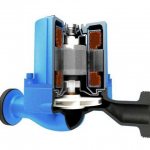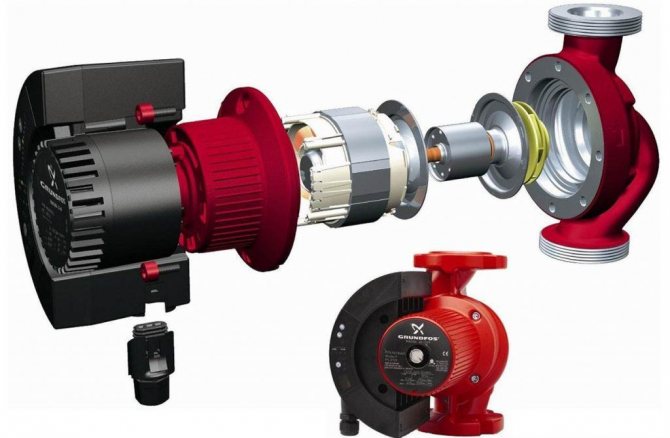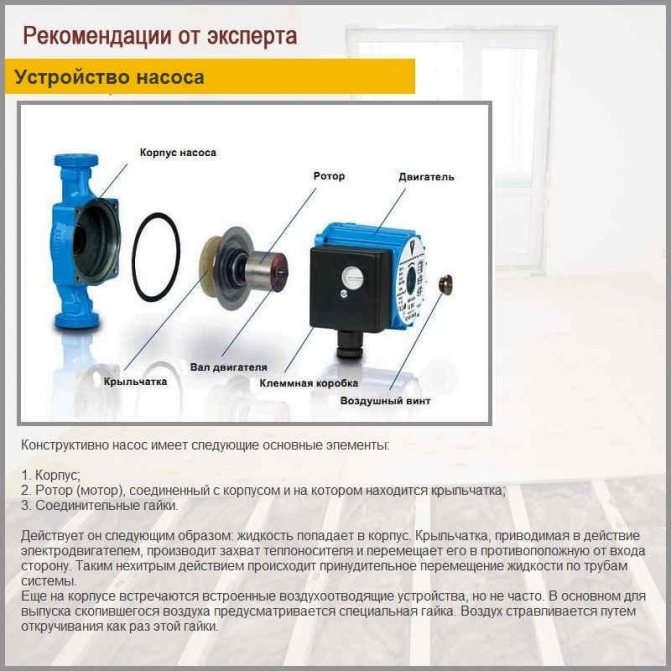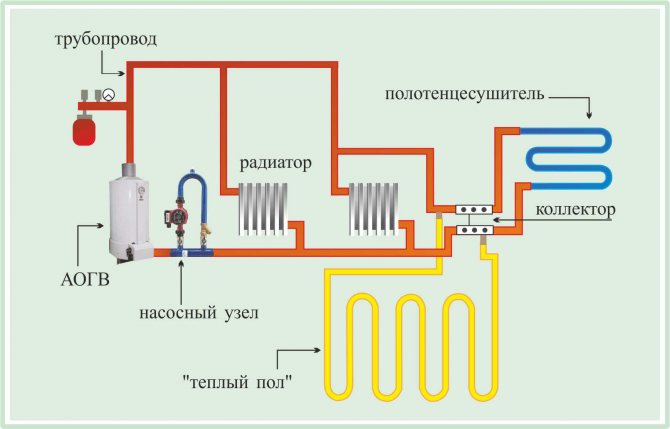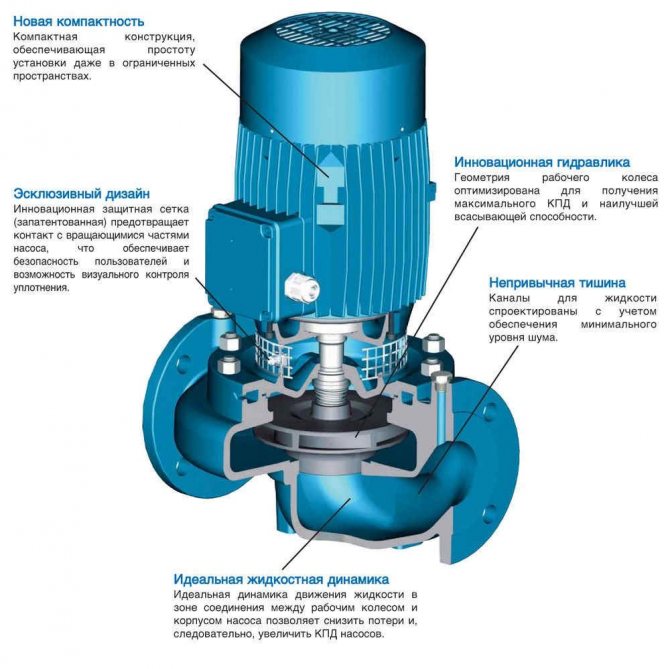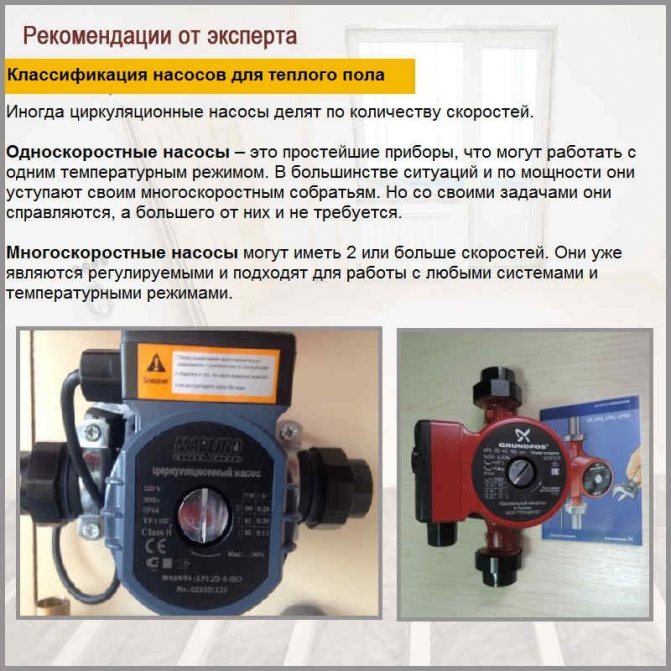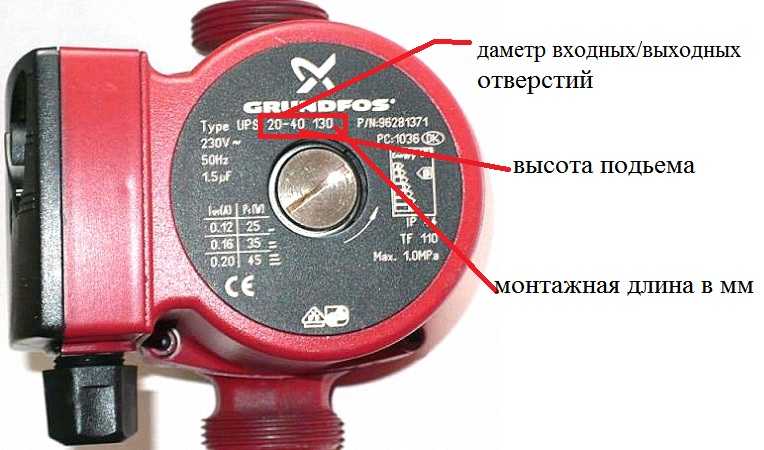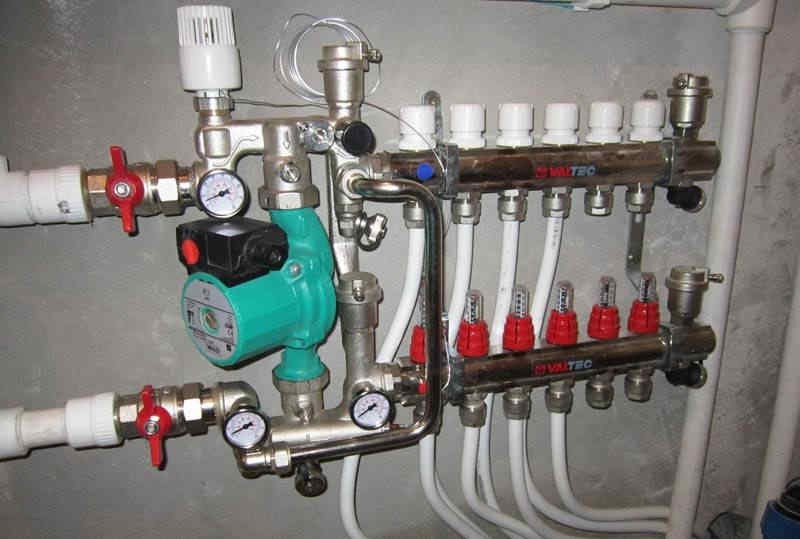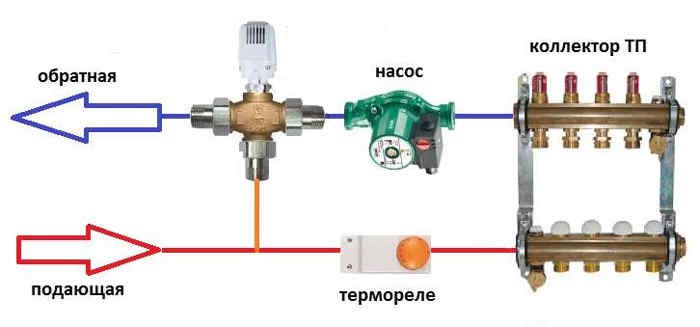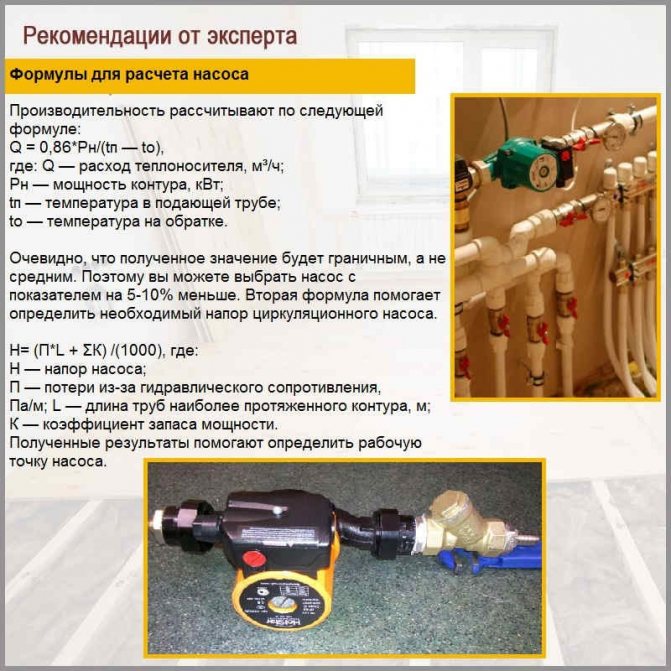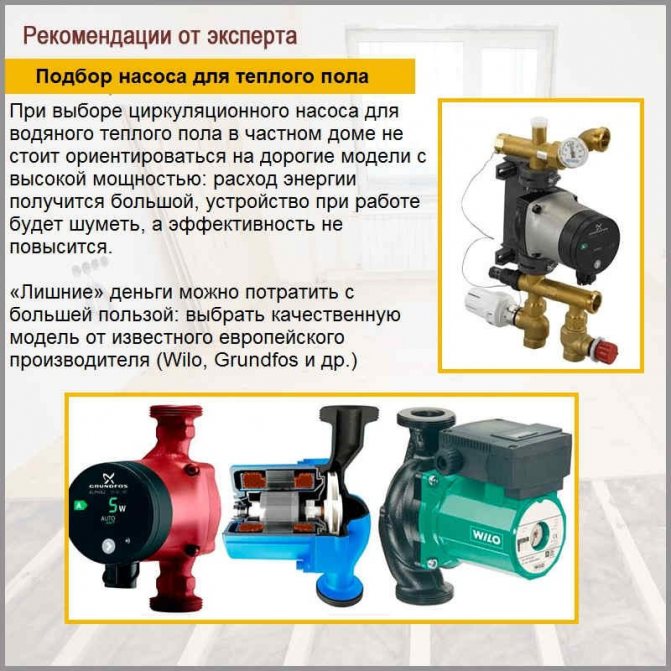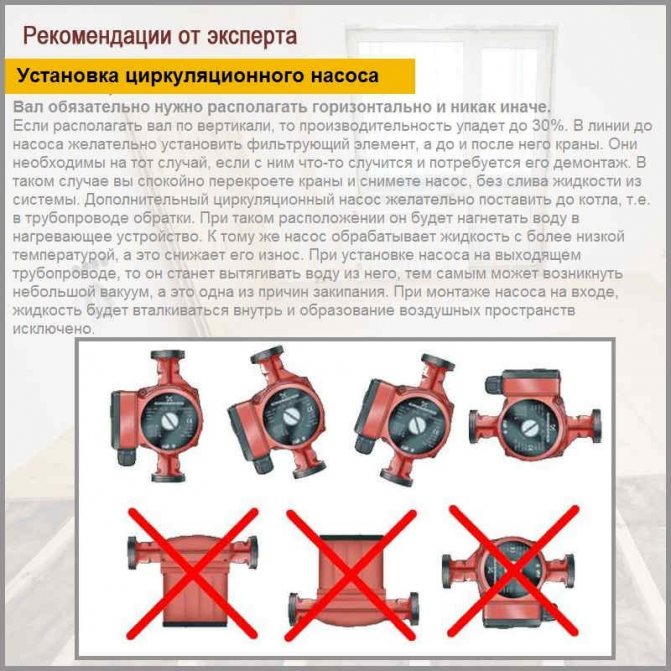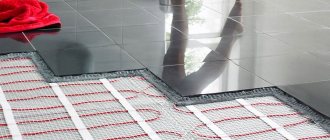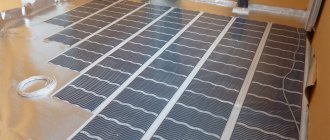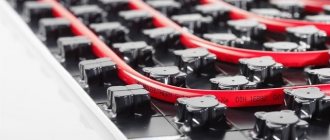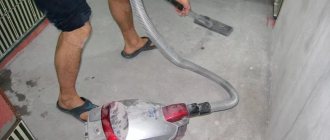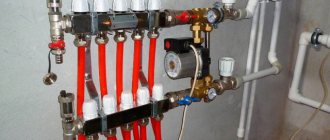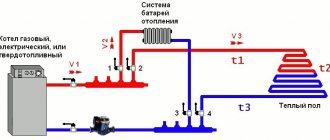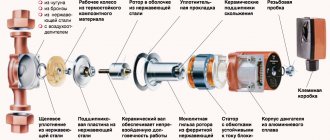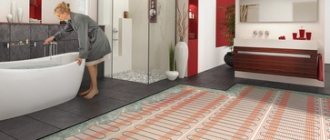A warm water floor with a heat carrier from a gas boiler is the most economical heating system for a country house.
With the correct calculation of the warm water floor and proper insulation of the house, the water floor will significantly outperform radiators in terms of efficiency.
Although in areas with a harsh climate, radiators are also installed.
When calculating underfloor heating with water heating, the area of the room, the characteristics of the house (the material from which it is made, the features of insulation, the design features of the windows), the desired floor temperature, as well as the type of flooring are taken into account.
For example, if the covering is to be made of a planed board, more system power will be required. wood conducts heat very poorly (see details on how to make warm water floors on a wooden floor).
Do I need a pump for a warm water floor
The pump circulates water in the circuit, thanks to which the surface heats up evenly and protects the house from heat loss, which is especially important for regions with extremely frosty winters. The installation of such a device is required, but not in all cases. It is believed that if the floor area is small (up to 40-50 m2), such a device does not need to be mounted.
In all other options, installation of the pump is necessary, and not only for reasons of comfort, but also due to some technical features:
- Often, pipes with a small cross-section are used for heating, therefore, large heat losses occur in them. Because of this, the boiler itself will overheat, more solid fuel will be needed.
- Certain types of flooring do not tolerate high temperatures - for example, laminate, oak deforms. Therefore, they need an even distribution of heat, which is what the water pump provides. In the calculation of such schemes, the mixing unit must be taken into account, which allows maintaining the desired mode.
- The walls of the house are made of one material, which has the same heat capacity. However, floors are most often made from different materials. For example, the bathroom has a ceramic coating, while in other rooms the floors can be self-leveling. As the heat capacities differ, it becomes necessary to distribute heat evenly.
Attention! More often than not, you should not rely on the floor contour and the heater group to operate from the same boiler. The parameters of these systems are noticeably different.
What pump is needed for underfloor heating
For a house with a typical area (up to 250-300 m2) and 1-2 floors, you can choose a pump equipped with a wet-type rotor, the impeller of which is submerged in water. This ensures low noise and durability (no need to constantly lubricate the mechanism). If the house has a large area or more than 2 floors, it is better to consider a model with a dry rotor. Therefore, it is necessary to clarify how exactly they differ:
- Wet rotor are devices with medium power, they are optimally suited for rooms up to 250-350 m2. The impeller of the mechanism is directly in the water. The equipment works quite quietly, while it consumes little energy and lasts a long time.
- Dry rotor - particularly powerful options. They are used on surfaces with an area of 250 m2 and more and require cleaning and lubrication. If the house has 3 or more floors, it should also be considered a dry rotor.
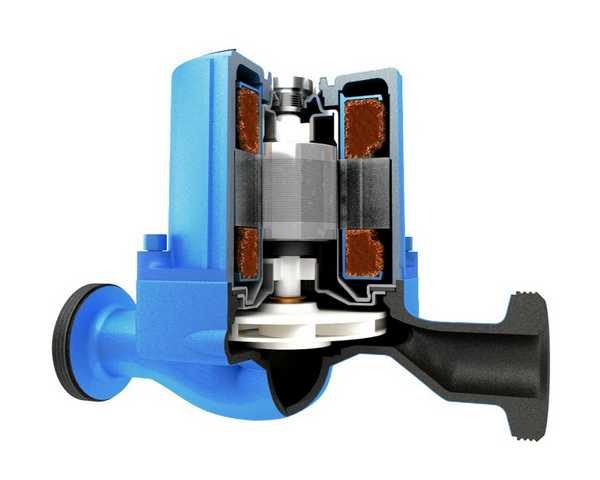
Wet rotor pumps are suitable for standard houses with an average floor space
Selection of circulation pumps
Pumps are selected according to a graphical characteristic that displays the dependence of the pressure developed by the pump on the flow of water passing through it.The operating point of the system, which is located at the intersection of the calculated flow rate and pressure, is applied to the graphical characteristic of the pump. The operating point of the system should be either on the pumping curve or slightly above it and as close as possible to the maximum efficiency pumping point. If several pumps meet the specified characteristics, you should give preference to a pump with a lower power, and if the flow rate will vary over a wide range, you should choose a pump with a flat performance.
When choosing a circulation pump for a heating or hot water supply system, one should take into account possible hydraulic imbalance, the main manifestation of which is unsatisfactory water circulation through circulation rings remote from the pumping unit. By choosing a pump with a flow and head margin, you can compensate for a slight hydraulic imbalance, therefore, when selecting a circulation pump for a heating system, it is recommended to choose a pump with a 10-20% head margin and a 20-30% flow margin. It should be borne in mind that when the flow rate increases by 1.3 times, the pressure loss in the system will increase by 1.3 * 1.3 = 1.7 times.
For heating systems with radiator thermostatic valves, a slight deficit in pump flow is allowed, justified by a 10% increase in the surface area of heating devices and a nonlinear decrease in heat transfer from a heating device with a change in flow.
Circulation pumps with electronic impeller speed control can significantly reduce energy costs in systems with dynamic hydraulic operation.
The noise characteristics of the pump often become the predominant factor when choosing circulation pumps installed in the engineering systems of residential buildings, for installation in rooms with a constant presence of people or adjacent rooms, it is recommended to give preference to pumps with a wet rotor, since they are distinguished by the quietest operation.
How to calculate the pump power for a warm floor
You can estimate this parameter according to the main technical characteristics, which are indicated by 2 numbers, for example: 25/40. The first value characterizes the thread diameter - in this case 25 mm, the second - the head: 40 dm or 4 m (that is, 0.4 atm). The choice depends on the floor area.
| up to 150 m2 | 25/40 |
| 150-260 m2 | 25/60 |
For an accurate calculation of the pressure, you can apply the following formula:
Nap = (C * D + k) / 1000, where:
- Hap - pressure;
- С - resistance (determined by 1 meter);
- D - pipe length;
- k - coefficient (characterizes the power reserve).
Important! If the area of the house is more than 250 m2, you can install 2 devices with a pressure of 25/40, you should not take it "with a margin", that is, with a high pressure, since it is impractical. Heating will be about the same, but noise and energy costs will increase significantly.
The capacity is determined by the volume of water passed per unit of time (m3 per hour). The selection of a suitable pump for underfloor heating can be done using the table.


An accurate calculation of the main characteristics of a pump for a warm floor can be done based on the following equality:
Explanation of the formula:
- Q - productivity;
- P is the power of the device;
- t1 is the temperature of the water or other medium in the return pipe;
- t2 is the temperature of the water or other media in the supply.
For houses with a larger area, the same principle works - it is better to install 2 pumps with average indicators than 1 device with high performance. In this case, you will need to calculate the indicator of each device, and then summarize the values obtained.
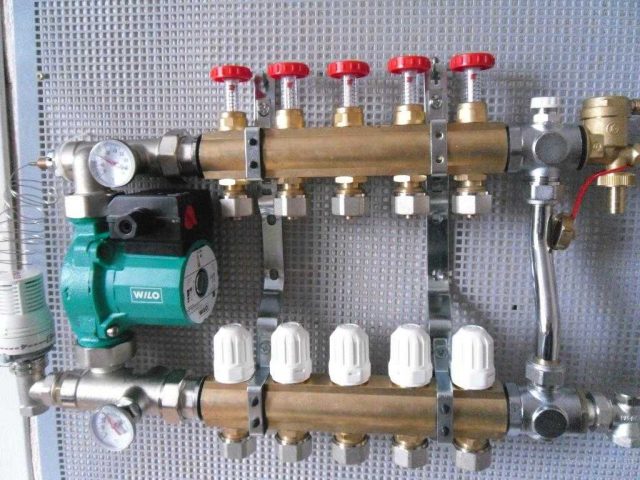

It is better to buy sufficiently efficient floor pumps (15-20% more than the calculated one) - this will help in the event of an abnormally cold winter or weak insulation of the house
Calculation of performance and power
For the arrangement of "warm floor", the main characteristics of the device and the possibility of its use will be pressure and performance. These parameters determine the power of the circulation device.
To calculate the required pump characteristics, you can use the existing tables and expressions for determining the consumption of the coolant.
Q = 0.86 * Ploop / (T supply - Tobr)
- Ploop - heating circuit power, kW.
- Tobr - the temperature of the coolant in the return pipeline.
- Tfeeding - temperature in the supply pipeline.
The next step is to calculate the value of the hydraulic resistance of the water circuit. The performance determined by the formula must be greater than the loop resistance.
If you have any doubts in the calculation, then entrust them to professionals
How to choose a pump for underfloor heating
It is recommended to consider several criteria:
- Technical characteristics (it is necessary to make preliminary calculations according to the formulas described above and determine the appropriate model).
- The pump body material is better cast iron, stainless steel or organic polymers. It is these materials that last the longest due to their high anti-corrosion properties.
- The presence of a built-in thermostat protects the impeller from scale and deposits that form due to exposure to hot water.
- Brand - Germany (Wilo) and Denmark (Grundofs) are the most reliable. Budget options with an optimal price / quality ratio - Poland (DAB) and China (Sprut). Also popular are Italian manufacturers (Lowara, Pedrollo) and the Japanese brand Ebara.
- High-speed floor pump - usually models operate at 3 speeds, which is especially convenient for a large heating area, as well as 2-3-storey buildings.
Where is the pump for underfloor heating installed?
Before connecting the pump to the underfloor heating, it is important to determine the optimal place for its installation. There are 2 options for this:
- At the feed - that is, next to the mixing unit.
- On the return line - that is, in front of the boiler.
In a conventional system, installers always use the second option - it is optimal to place the pump just in front of the boiler, from where it will give water flow, which will ensure its uniform heating. But in the case of underfloor heating, it is better to choose installation on the supply. This is done in order to avoid air entering the system as much as possible.
Important! If the floor pump is too noisy (rotary), it is better to install it under the floor. For medium-sized premises (1-2 floors, up to 300 m2), the equipment can be placed in other places.
Selection recommendations
To ensure normal circulation of hot water in the system, units should be selected based on the following recommendations:
- The aquatic environment contains oxygen, so you should not install a cast iron pump.
- In the aquatic environment, there is a sufficiently high content of salts that can settle on the rotor at a temperature of + 55 ° C and above. Therefore, a temperature regulator must be provided that will turn off the unit when it rises, that is, to work as a station.
- If the boiler is equipped with a standard control panel, then a timer is connected.
How to install a pump on a warm floor
After the location is selected, you should proceed with the installation. The algorithm of actions is as follows:
- First, a bypass is installed in the mounting place - a bypass pipe.
- To do this, you need to cut the main pipe.
- Form a thread at its ends.
- Install the ball valve and install the pump.
- Open the tap for water access.
- Open the air bleed screw.
- After installing the circulation pump on a warm floor, it is imperative to test the system. First, the operation is checked at low speed.
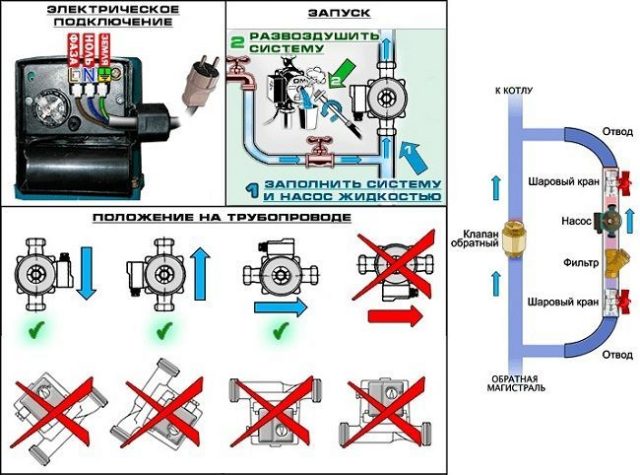

Scheme of the correct installation of the pump for underfloor heating
Pump cavitation
Pump cavitation occurs when the water pressure in the suction port drops to saturation pressure. In fact, cavitation is a sharp formation of steam bubbles and the same sharp collapse of them, as a result, sharp pressure surges at the pump impeller. Cavitation in the pump is not only accompanied by increased noise, but also accelerates the process of its wear.
It is possible to eliminate cavitation in the pump by ensuring the pressure in the suction pipe is higher than the saturation pressure of the water. It should be noted that the saturation pressure depends on the water temperature, the lower it is, the lower the saturation pressure.
Some manufacturers indicate the cavitation characteristic of the pump - NPHS - numerically equal to the minimum absolute pressure in the suction pipe of the pump, at which cavitation-free operation is guaranteed.
KSB Manual Sizing Centrifugal Pumps
Reading time: 2 minutes No time?
Dachas and private houses are most often not connected to centralized heating. That is why the owners themselves install various boilers and stoves, with the help of which they heat their living quarters. But it is not enough to correctly mount the heating system. It is also necessary to choose a pump that will force the coolant to circulate through the pipes. After all, the efficiency of the system and its rapid warming up depend on the characteristics of the circulation pump. How do you calculate the required performance? This will help the online calculator for calculating the performance of the circulation pump.
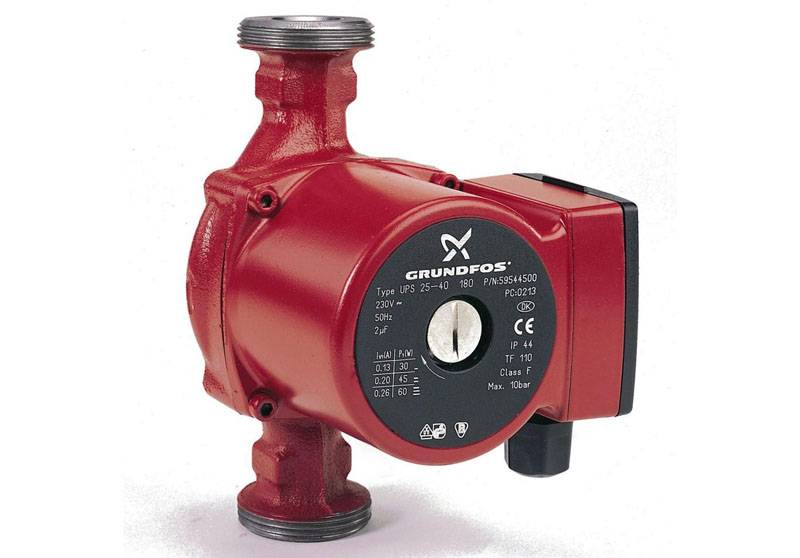

The circulation pump is necessary for the normal functioning of the heating
Maintenance rules for a pump for a warm water floor
The pump for underfloor heating is durable, provided that it is correctly installed and there is no factory defect. However, it also needs maintenance. During operation it is necessary:
- Periodically (1-2 times a month) bleed air from the circuit using a special tap. If you have to do this too often, there are installation errors. It is recommended to install additional separators or air valves.
- Lubricate the working mechanism annually - this is especially necessary for a pump with a dry rotor.
- As for a wet rotor, it is necessary sometimes (for example, once every 2-3 years) to clean it from scale and other deposits.
Important! The pressure and temperature should not be drastically changed. If a place is frozen (or after a long break), heating is carried out very slowly so that the water gradually acquires the desired temperature.
Classification
There are two types of aggregates:
- Dry type - the liquid does not come into contact with the motor rotor, rubber rings or cuffs are used for isolation. Powerful, high efficiency. Neutral to water hardness.
- Wet type - monoblock design, the rotor rotates in a liquid, which in this case serves as a lubricant. Works silently. Maintains working condition for a long period due to minimal wear of parts. Due to its low power, it consumes a small amount of electricity.
Speed classification:
- single-speed - work with one temperature regime;
- multi-speed - speeds more than two, applicable for any systems with different temperatures.
For arranging a heated floor surface, the choice of a three-speed type may be ideal. When water passes through the pipes, its temperature decreases. The more stable the speed of movement, the more evenly the heat transfer occurs over the entire surface.

